The Northern Rockies Fire Science Network and the Southwest Fire Science Consortium were pleased to host a webinar with Sean Parks, Landscape Ecologist with the Aldo Leopold Wilderness Research Institute (ALWRI).
This webinar highlighted results from a study investigating the ability of wildfire to act as a fuel treatment. The study evaluated whether or not wildfires limited the occurrence, size, and severity of subsequent wildfires in four large wilderness complexes in Idaho, Montana, and New Mexico. The study focused on protected areas to minimize anthropogenic factors (e.g., roads and fuel treatments) that may affect fire behavior and effects.
Study findings suggested that -
- Wildfires reduce the probability that subsequent fires will ignite and spread.
- Wildfires reduce the size of subsequent fires by acting as fuel breaks.
- Subsequent fire severity is significantly lower in areas that have recently burned than in areas that have not.
The strength and longevity of the moderating effect of wildfires on subsequent fires varied by study area, suggesting that ecosystem-level processes controlling fire regime characteristics and regrowth of vegetation are responsible for these differences.
